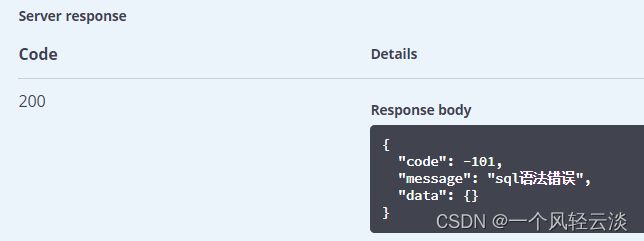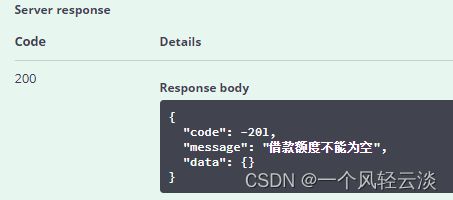微服务项目:尚融宝(10)(后端接口:统一异常处理)
认清现实,放弃幻想,准备斗争
一、项目中的异常
1、制造异常
屏蔽 IntegralGrade 中的 @TableField注解
@ApiModelProperty(value = "逻辑删除(1:已删除,0:未删除)")
//@TableField("is_deleted")
@TableLogic
private Boolean deleted;2、Swagger中测试
测试列表查询功能,查看结果,发生错误,显示响应失败
二、统一异常处理
目标:我们想让异常结果也显示为统一的返回结果对象,并且统一处理系统的异常信息,那么需要进行统一异常处理。
1、创建统一异常处理器
guigu-common中创建exception包,创建统一异常处理器类UnifiedExceptionHandler
@Slf4j
@Component //Spring容易自动管理
@RestControllerAdvice //在controller层添加通知。如果使用@ControllerAdvice,则方法上需要添加@ResponseBody
public class UnifiedExceptionHandler {
/**
* 未定义异常
*/
@ExceptionHandler(value = Exception.class) //当controller中抛出Exception,则捕获
public R handleException(Exception e) {
log.error(e.getMessage(), e);
return R.error();
}
}2、service-core添加扫描
添加 "com.atguigu.common"
@SpringBootApplication
@ComponentScan({"com.atguigu.srb", "com.atguigu.common"})
public class ServiceCoreApplication {3、测试
返回统一错误结果
三、处理特定异常
如果我们不想显示统一的“服务器内部错误”,需要个性化的显示异常信息,那么需要针对特定的异常做处理
1、添加依赖
在guigu-common中添加jdbc依赖
org.springframework
spring-jdbc
2、添加异常处理方法
在 UnifiedExceptionHandler 中添加
/**
* 特定异常
*/
@ExceptionHandler(BadSqlGrammarException.class)
public R handleBadSqlGrammarException(BadSqlGrammarException e){
log.error(e.getMessage(), e);
return R.setResult(ResponseEnum.BAD_SQL_GRAMMAR_ERROR);
}3、测试
问题:上面的例子虽然针对特定的异常显示个性化的错误信息,但是你会发现,针对每个不同的异常我们都需要在项目中添加对应的处理方法,并捕获对应的异常对象,可能还要针对这个异常添加额外的依赖。这显然不是最好的方式。
方案:此类异常直接抛出,并且用Exception类捕获就可以了。
4、恢复制造的异常
@TableField(value = "is_deleted")四、自定义异常
目标:使用一个或较少的异常类,可以捕获和显示所有的异常信息。
方案:因此,我们可以创建一个自定义异常类(必须是运行时异常),在程序中抛出这个自定义异常对象,并在统一异常处理器中捕获自定义异常对象
1、创建自定义异常类
@Data
@NoArgsConstructor
public class BusinessException extends RuntimeException {
//状态码
private Integer code;
//错误消息
private String message;
/**
*
* @param message 错误消息
*/
public BusinessException(String message) {
this.message = message;
}
/**
*
* @param message 错误消息
* @param code 错误码
*/
public BusinessException(String message, Integer code) {
this.message = message;
this.code = code;
}
/**
*
* @param message 错误消息
* @param code 错误码
* @param cause 原始异常对象
*/
public BusinessException(String message, Integer code, Throwable cause) {
super(cause);
this.message = message;
this.code = code;
}
/**
*
* @param resultCodeEnum 接收枚举类型
*/
public BusinessException(ResponseEnum resultCodeEnum) {
this.message = resultCodeEnum.getMessage();
this.code = resultCodeEnum.getCode();
}
/**
*
* @param resultCodeEnum 接收枚举类型
* @param cause 原始异常对象
*/
public BusinessException(ResponseEnum resultCodeEnum, Throwable cause) {
super(cause);
this.message = resultCodeEnum.getMessage();
this.code = resultCodeEnum.getCode();
}
}2、添加异常处理方法
UnifiedExceptionHandler类中添加
/**
* 自定义异常
*/
@ExceptionHandler(BusinessException.class)
public R handleBusinessException(BusinessException e){
log.error(e.getMessage(), e);
return R.error().message(e.getMessage()).code(e.getCode());
}3、修改Controller
@ApiOperation("新增积分等级")
@PostMapping("/save")
public R save(
@ApiParam(value = "积分等级对象", required = true)
@RequestBody IntegralGrade integralGrade){
//如果借款额度为空就手动抛出一个自定义的异常!
if(integralGrade.getBorrowAmount() == null){
//BORROW_AMOUNT_NULL_ERROR(-201, "借款额度不能为空"),
throw new BusinessException(ResponseEnum.BORROW_AMOUNT_NULL_ERROR);
}
boolean result = integrationService.save(integralGrade);
if (result) {
return R.ok().message("保存成功");
} else {
return R.error().message("保存失败");
}
}4、测试
测试
结果
五、异常处理优化
目标:以优雅的 Assert(断言) 方式来校验业务的异常情况,消除 if else
1、什么是断言
public class AssertTests {
//if else的用法
@Test
public void test1() {
Object o = null;
if (o == null) {
throw new IllegalArgumentException("用户不存在.");
}
}
//断言的用法:更为简洁
@Test
public void test2() {
// 另一种写法
Object o = null;
Assert.notNull(o, "用户不存在.");
}
}2、自定义断言
用断言的方式封装异常的抛出
@Slf4j
public abstract class Assert {
/**
* 断言对象不为空
* 如果对象obj为空,则抛出异常
* @param obj 待判断对象
*/
public static void notNull(Object obj, ResponseEnum responseEnum) {
if (obj == null) {
log.info("obj is null...............");
throw new BusinessException(responseEnum);
}
}
}3、修改controller
在controller中用断言替换if else
Assert.notNull(integralGrade.getBorrowAmount(), ResponseEnum.BORROW_AMOUNT_NULL_ERROR);六、Controller上层异常
1、异常分类
对异常按阶段进行分类,大体可以分成:进入Controller前的异常 和 业务层异常,具体可以参考下图:
2、处理Controller上层异常
UnifiedExceptionHandler中添加
/**
* Controller上一层相关异常
*/
@ExceptionHandler({
NoHandlerFoundException.class,
HttpRequestMethodNotSupportedException.class,
HttpMediaTypeNotSupportedException.class,
MissingPathVariableException.class,
MissingServletRequestParameterException.class,
TypeMismatchException.class,
HttpMessageNotReadableException.class,
HttpMessageNotWritableException.class,
MethodArgumentNotValidException.class,
HttpMediaTypeNotAcceptableException.class,
ServletRequestBindingException.class,
ConversionNotSupportedException.class,
MissingServletRequestPartException.class,
AsyncRequestTimeoutException.class
})
public R handleServletException(Exception e) {
log.error(e.getMessage(), e);
//SERVLET_ERROR(-102, "servlet请求异常"),
return R.error().message(ResponseEnum.SERVLET_ERROR.getMessage()).code(ResponseEnum.SERVLET_ERROR.getCode());
}3、测试
在save测试用例中输入非法的json参数,则得到下面的结果。我们可以在控制台日志中查看具体的错误原因。前端只需要返回相对简单友好的提示即可。






